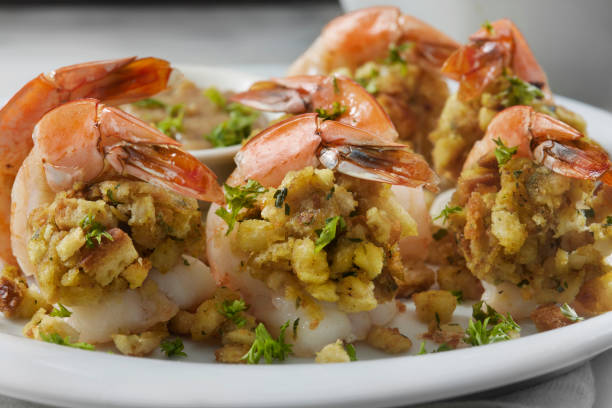If you’re a seafood enthusiast, shrimp undoubtedly occupies a special place on your menu. But have you ever wondered, can you eat shrimp tails? Today, we’re delving into the nitty-gritty of shrimp consumption, and our main spotlight is on the shrimp tail.
What are Shrimp Tails?
Shrimp tails are the hard, translucent segments that cap the rear end of this delicious crustacean. While most people view this part as inedible, throwing them away after peeling off the rest of the shell, some food cultures embrace the tails as part of their shrimp experience.
Can You Eat Shrimp Tails?
The straightforward answer is yes. Shrimp tails are entirely edible. While their texture may differ from the succulent meat most people are used to, they are safe to consume. In fact, some cultures, particularly in Asia, relish the crunchiness that the shrimp tails add to their meals.
Can You Eat Fried Shrimp Tails?
Absolutely! If you haven’t tried them already, fried shrimp tails add a delectable twist to your shrimp delicacies. Frying makes them crispy, adding a unique flavor and texture that complements the shrimp meat beautifully. This approach is common in Asian cuisines, where crispy shrimp tails play a significant role in dishes like shrimp tempura.

can you eat fried shrimp tails
Can You Eat Cooked Shrimp Tails?
Just like fried shrimp tails, cooked tails can be a delight. They are often used to enhance the flavor of broths and stocks, serving as a base for soups and sauces. Notable dishes that utilize cooked shrimp tails include gumbo and shrimp bisque.
How Can You Tell Whether or Not You Can Eat Shrimp Tails?
Selecting shrimp suitable for tail-eating largely depends on the size, freshness, and quality of the shrimp. Generally, larger shrimps have more robust tails, which after cooking, can be quite appetizing. It’s also essential to properly clean and prepare the shrimp, which includes removing the vein and antennae.
Is Shrimp Good for You?
Shrimp boasts a myriad of health benefits, mainly due to its high protein content and significant amount of omega-3 fatty acids. However, like any other seafood, shrimp does contain cholesterol and trace amounts of mercury. Experts recommend moderation in shrimp consumption, balancing it with a variety of other nutrient-dense foods. Did you know that Asparagus is Bad when it’s overcooked? It loses many of its valuable nutrients. Hence, combining shrimp with raw or lightly cooked asparagus can make for a perfectly balanced meal.

Is It Healthy to Eat the Shrimp Shells?
Shrimp shells, like shrimp tails, can be consumed and offer certain health benefits, including a good source of calcium and fiber. However, if you suffer from shellfish allergies, consuming shrimp shells might trigger a reaction. If you’re planning to use shrimp shells in your cooking, consider frying or grinding them into powder for a more enjoyable texture.
Remember, always ensure that your shrimp – whether you’re eating the tail, shell, or delicious meat – is properly cooked. You can even try pairing your shrimp with delicious sides such as Cook Frozen Ravioli for a delightful meal.
Shrimp Tails Consumption: Suitable Age and Health Implications
Shrimp is a culinary delight savored by people across the globe, but when it comes to shrimp tails, there’s often a divide. Some individuals enjoy the crunchiness of fried or cooked shrimp tails, while others prefer to discard them. A question that frequently arises in this context is, what age is appropriate to start eating shrimp tails and are they beneficial to health? Let’s explore.
When Can One Start Eating Shrimp Tails?
Before introducing shrimp or any seafood to a child’s diet, it’s essential to consider the risk of allergies. Shrimp falls under the category of shellfish, one of the most common food allergens. It’s generally recommended to wait until a child is at least one year old before introducing shrimp, and even then, start with small amounts of the meaty portion.
As for the shrimp tails, their hard, crunchy texture might pose a choking hazard for young children. It’s advisable to wait until a child can safely manage such textures, typically around the age of 4 or 5. However, always ensure that the child eats small, manageable pieces and is supervised while eating.
Health Implications of Eating Shrimp Tails
While the thought of eating shrimp tails might make some people recoil, they are entirely edible and contain nutrients such as calcium and chitosan. Here’s a closer look at what these nutrients offer:
- Calcium: Shrimp tails are rich in calcium, which is essential for bone health. This is particularly beneficial for older adults who might be at risk of osteoporosis.
- Chitosan: This is a type of fiber derived from the shells of crustaceans like shrimp. Some studies suggest that chitosan can help lower bad cholesterol levels and might aid in weight loss.
However, like any other food, shrimp tails should be consumed in moderation. Overconsumption might not be beneficial, and for individuals with shellfish allergies, it could trigger allergic reactions.
Shrimp tails can be an interesting addition to your culinary adventures, their consumption depends on the individual’s age, texture preference, and allergy concerns. Always remember to enjoy your shrimp responsibly and in moderation. Happy eating!
Conclusion
The tail-end question of ‘Can you eat shrimp tails’ is a resounding yes. Whether you choose to eat them or not is a matter of personal preference and culinary adventure. Try it out and let us know your experience in the comments below. Perhaps the question ‘can you eat asparagus raw?’ might be your next culinary investigation.
